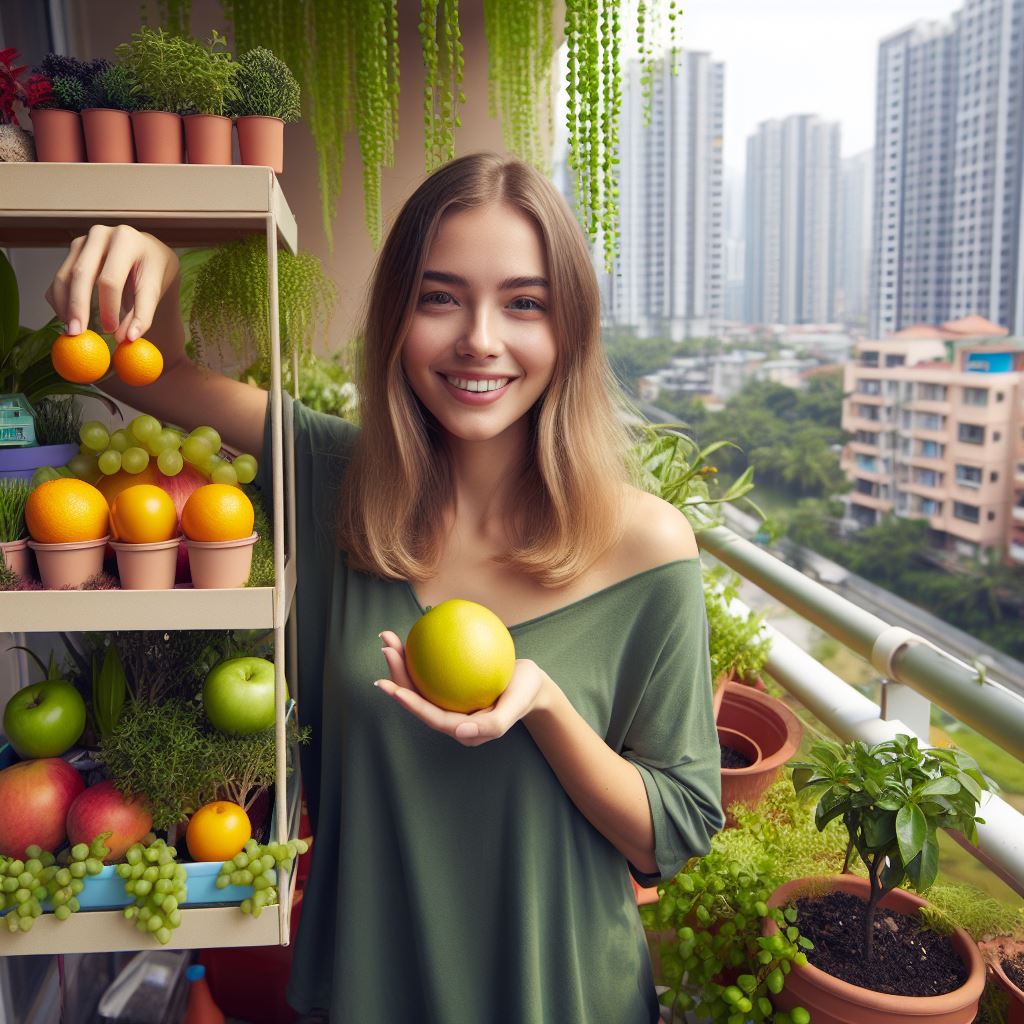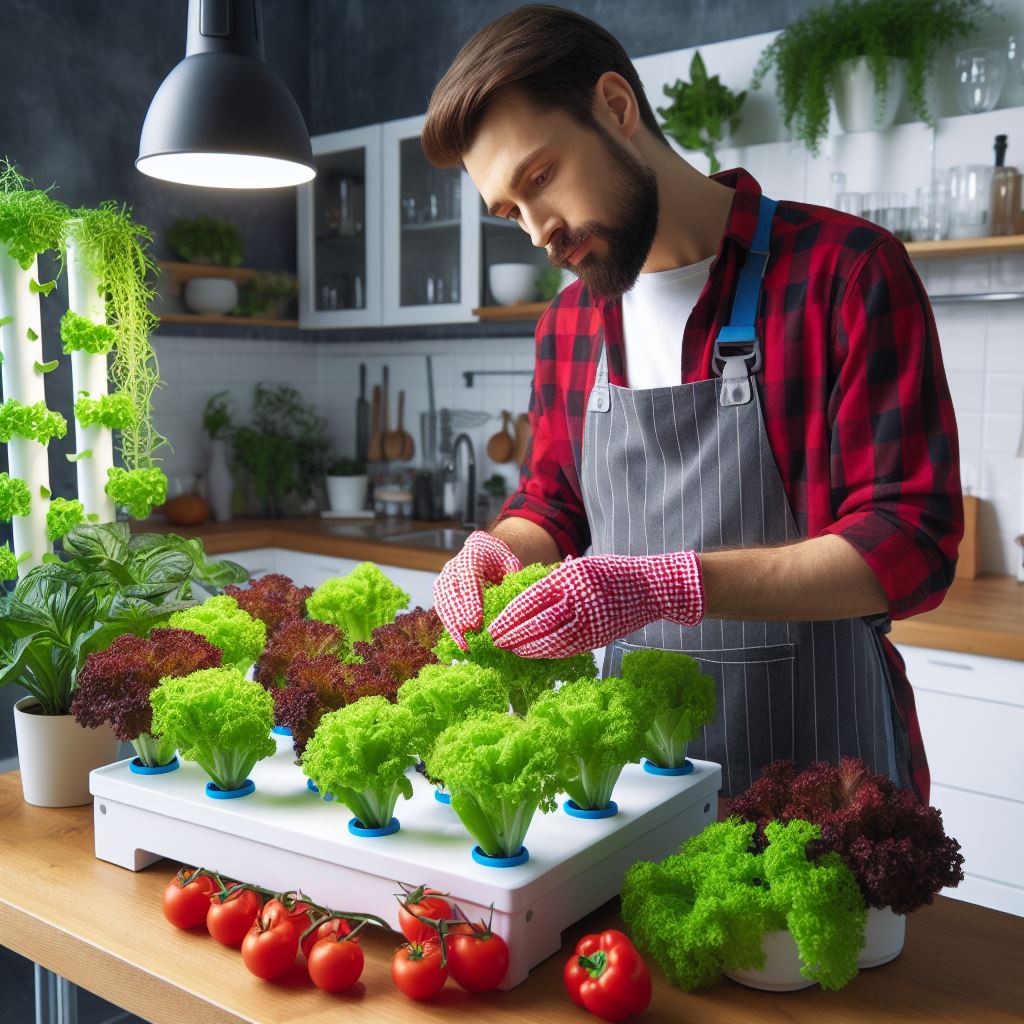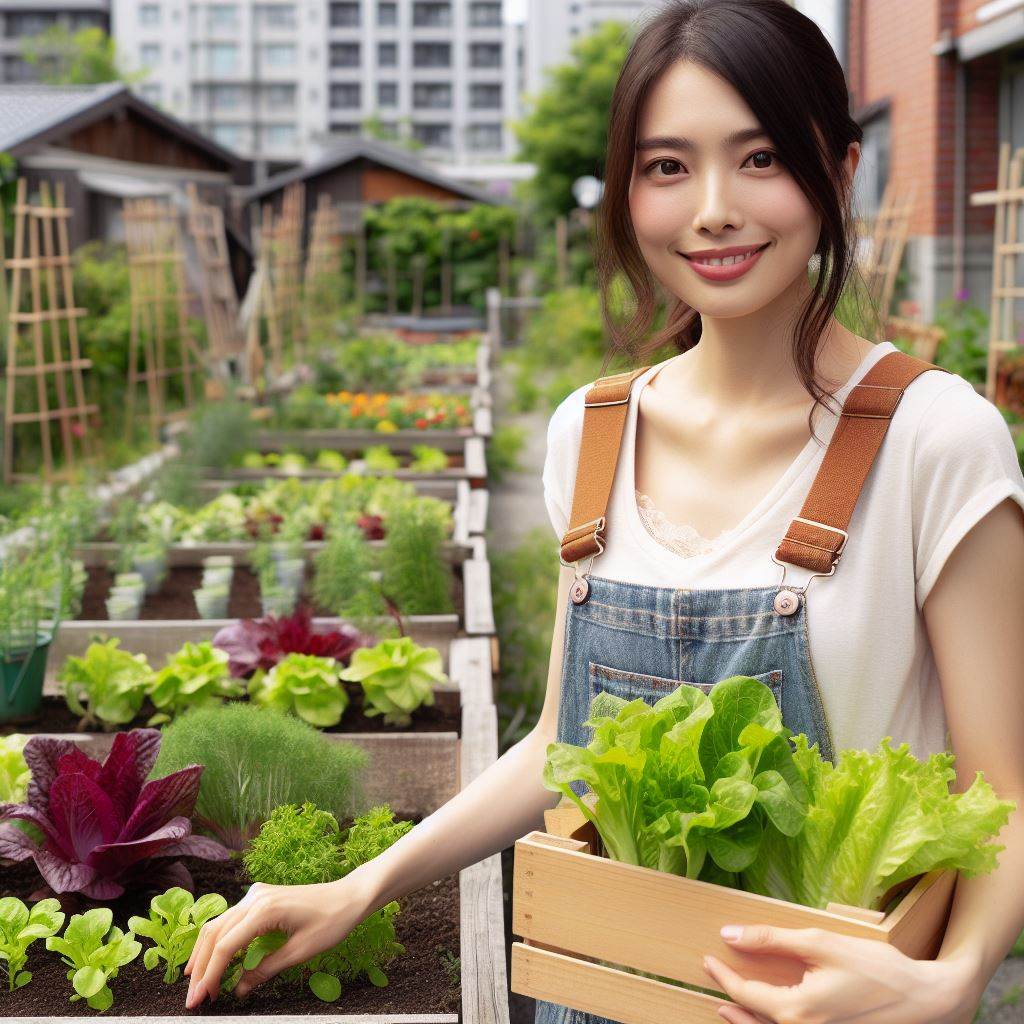Introduction
Urban gardening and balcony farming have become increasingly popular as people seek ways to grow their own food in small spaces.
Maximizing the use of tiny areas for fruit farming is essential for sustainability and self-sufficiency.
Brief overview of the increasing popularity of urban gardening and balcony farming
With the rise of urbanization, many individuals are turning to urban gardening and balcony farming as a means to reconnect with nature and produce their own fresh, organic fruits and vegetables.
The convenience and accessibility of growing food on balconies or in small areas have garnered significant attention in recent years.
Importance of utilizing small spaces effectively for fruit farming
Utilizing small spaces effectively for fruit farming is crucial in maximizing the potential of urban gardening.
Small areas such as balconies or even window sills can be transformed into fruitful gardens, providing a sustainable source of fresh produce.
This not only reduces dependence on store-bought fruits but also promotes a healthier lifestyle by consuming pesticide-free, homegrown fruits.
By carefully selecting fruit varieties suitable for container gardening, utilizing vertical gardening techniques, and implementing efficient space-saving strategies such as trellises and hanging baskets, even the smallest of areas can yield a bountiful harvest.
The use of dwarf fruit trees, berry bushes, and climbers allows for the cultivation of a wide range of fruits in limited spaces.
Balcony fruit farming provides numerous benefits, including improved air quality, enhanced aesthetics, and the joy of harvesting one’s own produce.
Additionally, it offers a sustainable solution to food insecurity and reduces the carbon footprint associated with long-distance transportation of imported fruits.
As urbanization continues to transform our living spaces, the popularity of urban gardening and balcony farming will only grow.
Utilizing small spaces effectively for fruit farming not only provides individuals with a source of fresh, organic fruits but also contributes to a greener and more sustainable future.
With proper planning, care, and innovative techniques, anyone can enjoy the rewards of balcony fruit farming, no matter how tiny the area may be.
Benefits of Balcony Fruit Farming
Accessibility and convenience of having fresh fruits at home
By practicing balcony fruit farming, you can easily access and enjoy fresh fruits daily.
Transform Your Agribusiness
Unlock your farm's potential with expert advice tailored to your needs. Get actionable steps that drive real results.
Get StartedNo need to visit the grocery store or market, saving time and effort.
Potential cost savings by growing fruits on the balcony
Growing your own fruits can significantly reduce your grocery bills.
You only need to invest in seeds, pots, and basic gardening supplies, which are relatively inexpensive.
Environmental benefits of reducing food transportation and packaging
Producing fruits on your balcony reduces the need for transportation, decreasing carbon emissions.
Since you don’t rely on packaged fruits, it helps in reducing plastic waste and environmental pollution.
Health advantages of consuming homegrown fruits
Balcony fruit farming ensures that you consume fresh, pesticide-free fruits.
Homegrown fruits are packed with essential nutrients, vitamins, and antioxidants, benefiting your overall health.
Improved mental well-being and stress reduction
Gardening and nurturing plants can be therapeutic and relieve stress.
Balcony fruit farming provides a fulfilling and calming experience, improving your mental well-being.
Educational opportunities for children and adults alike
Balcony fruit farming offers an excellent learning platform for children to understand the process of food production.
Adults can also develop new skills and knowledge in gardening, fostering a sense of self-sufficiency.
Community-building through sharing and exchanging produce
Balcony fruit farming enables you to cultivate a sense of community by sharing your harvest with neighbors or friends.
Exchanging produce allows for a deeper connection and promotes a sustainable and supportive neighborhood.
Increased biodiversity and support for pollinators
Balconies filled with fruits attract pollinators like bees and butterflies, contributing to a healthier ecosystem.
By creating a mini garden, you provide a habitat for various organisms, increasing biodiversity in your area.
Satisfaction of growing your own food
Balcony fruit farming gives a sense of accomplishment from growing and harvesting your own food.
It reconnects you with nature and the process of food production, creating a fulfilling experience.
Fun and creative outlet for gardening enthusiasts
Balcony fruit farming allows gardening enthusiasts to indulge in their hobby even in limited spaces.
It provides an outlet to express creativity through plant arrangement, unique growing techniques, and fruit variety selection.
Improved air quality and microclimate regulation
Plants produce oxygen and help filter out pollutants, contributing to better air quality in your balcony area.
Large leafy plants can also regulate microclimates, reducing heat and providing shade during hot summer days.
Reduced dependence on external food sources
By practicing balcony fruit farming, you become less dependent on external food sources.
This increases your self-sufficiency and resilience, especially during times of food scarcity or emergencies.
Essentially, balcony fruit farming offers numerous benefits, including accessibility to fresh fruits, potential cost savings, and environmental advantages.
Showcase Your Farming Business
Publish your professional farming services profile on our blog for a one-time fee of $200 and reach a dedicated audience of farmers and agribusiness owners.
Publish Your ProfileIt promotes a healthy lifestyle, supports mental well-being, and provides educational opportunities.
Additionally, it fosters community-building, encourages biodiversity, and enhances the satisfaction of growing your own food.
Embrace this fun and creative gardening outlet to enjoy the many advantages it brings to tiny areas.
Read: Eco-Friendly Farming: Aquaponics Insights
Choosing the Right Fruit Varieties for Balcony Farming
When it comes to balcony fruit farming, selecting the right fruit varieties is crucial for a successful harvest.
Here are some considerations to keep in mind:
Considerations for Selecting Fruit Varieties Suitable for Container Gardening
Container gardening has its limitations, so it’s important to choose fruit varieties that are well-suited for growing in pots and small spaces.
Here are a few factors to consider:
- Size: Opt for dwarf or compact varieties that don’t take up too much space.
- Compatibility with Container Gardening: Some fruit trees and bushes have shallow root systems, making them ideal for containers.
- Climate Adaptability: Choose fruit varieties that can thrive in your specific climate and microclimate.
Examples of Fruit Trees and Bushes That Thrive Well in Small Spaces
If you’re limited in space but still want to enjoy homegrown fruit, here are some fruit trees and bushes that are well-suited for balcony farming:
- Blueberries: These compact bushes do well in pots and provide delicious berries.
- Dwarf Apple Trees: Look for varieties specifically bred to stay small, such as ‘Urban Apple’.
- Citrus Trees: Consider dwarf lemon, lime, or calamondin trees, which can be grown in containers.
- Strawberries: These low-growing fruits can be easily grown in hanging baskets or vertical planters.
- Grapes: Look for dwarf grape varieties or train them to grow vertically on trellises.
- Raspberries: Some raspberry varieties, like ‘Raspberry Shortcake,’ are compact and perfect for containers.
Remember to check the specific requirements for each fruit variety before planting.
Some may need support structures or specific soil conditions to thrive.
Choosing the right fruit varieties for balcony farming is essential to maximize your harvest in small spaces.
Consider factors like size, compatibility with container gardening, and climate adaptability when making your selection.
Don’t forget to research and provide the necessary care each fruit variety needs.
Happy balcony fruit farming!
Read: Indoor Eden: Hydroponic Systems for Home

Preparing the Balcony for Fruit Farming
Assessing sunlight exposure and microclimate conditions on the balcony
One of the first steps in preparing your balcony for fruit farming is to assess the amount of sunlight it receives.
Ensure that your balcony gets at least 6 hours of direct sunlight each day.
Observe the microclimate conditions on your balcony, such as wind patterns and temperature fluctuations.
This will help you determine which types of fruit plants will thrive in your specific balcony environment.
Purchasing or constructing suitable containers for fruit farming
Select containers that are appropriate for fruit farming on a balcony. Look for containers that are large enough to accommodate the roots of the fruit plants.
Consider using containers with built-in trellises or supports for vining plants like tomatoes or grapes.
This will help maximize space and promote healthy growth.
You can purchase containers from gardening stores or repurpose items such as plastic drums or wooden crates.
Ensure that the containers have drainage holes to prevent waterlogging.
Ensuring proper drainage and soil quality for healthy plant growth
To ensure healthy plant growth, it is crucial to provide proper drainage for the fruit plants on your balcony.
Avoid waterlogging, as it can lead to root rot and other diseases.
Use a well-draining potting mix that is specifically formulated for fruit plants.
This will ensure that the plants receive the necessary nutrients and moisture.
Consider adding organic matter such as compost or worm castings to the soil to improve its fertility.
Regularly check the moisture level of the soil and adjust watering accordingly.
Implementing a suitable watering and maintenance routine
Create a watering and maintenance routine that suits the needs of your fruit plants.
Water the plants regularly, but avoid overwatering as it can lead to root rot.
Regularly inspect the plants for pests and diseases.
Treat any infestations immediately using organic methods or consult with a local garden center for suitable remedies.
Prune the plants regularly to promote healthy growth and remove any dead or damaged branches.
Provide support or trellises for climbing plants to ensure proper growth.
Harvesting and enjoying your balcony-grown fruits
Once your fruit plants start to produce fruit, it’s time to harvest and enjoy the fruits of your labor.
Harvest when the fruits are ripe and at their peak flavor.
Choose the appropriate harvesting method for each type of fruit.
Showcase Your Farming Business
Publish your professional farming services profile on our blog for a one-time fee of $200 and reach a dedicated audience of farmers and agribusiness owners.
Publish Your ProfileSome fruits may be easily plucked by hand, while others may require scissors or pruners to cut them from the plant.
Store harvested fruit properly to prolong their shelf life. Refrigerate or consume them promptly to enjoy their freshness and flavor.
In essence, preparing your balcony for fruit farming requires assessing sunlight exposure, choosing suitable containers, ensuring proper drainage and soil quality.
Implement a maintenance routine, and you’ll soon be harvesting your own delicious fruits.
Read: Fish-Powered Gardens: Aquaponics Guide
Planting and Caring for Balcony Fruit Trees
Want to enjoy fresh fruits but have limited space? Balcony fruit farming is the solution!
Selecting the right potting soil mix and fertilizers for balcony fruit farming
- Use a well-draining and nutrient-rich potting soil mix specifically formulated for fruit trees.
- Look for organic fertilizers that provide a balanced blend of macro and micronutrients.
- Avoid chemical fertilizers as they can harm the environment and affect the fruit’s quality.
Proper planting techniques for fruit trees in containers
- Choose compact fruit tree varieties suitable for container gardening.
- Ensure the container has proper drainage holes to prevent waterlogging.
- Select a container size that allows enough space for the root system to grow.
- Position the tree in a sunny spot on your balcony to ensure sufficient sunlight exposure.
- Plant the tree at the same depth it was in its nursery container, ensuring the root ball is covered.
- Water the tree thoroughly after planting to settle the soil and promote root establishment.
Regular watering, pruning, and pest management practices
- Water your balcony fruit trees consistently, keeping the soil moist but not waterlogged.
- Aim for a deep watering once a week, focusing on the root zone.
- Monitor the moisture level by sticking your finger into the soil about an inch deep.
- Prune your fruit trees in late winter or early spring to remove dead or diseased branches.
- Pruning helps maintain the tree’s shape, improve air circulation, and promote fruit production.
- Inspect your trees regularly for signs of pests, such as aphids, mites, or mealybugs.
- Use organic pest control methods or insecticidal soap to manage common fruit tree pests.
With proper care and attention, you can successfully grow fruit trees on your balcony and enjoy a bountiful harvest.
Happy gardening!
Read: Hydroponics vs. Soil: What’s Best for You?
Maximizing Space and Yield in Balcony Fruit Farming
When it comes to balcony fruit farming, space optimization is key for maximizing yield.
Here are some tips:
Utilizing Vertical Gardening Techniques for Space Optimization
- Consider using vertical gardening techniques such as trellises, hanging baskets, and wall-mounted planters.
- These techniques allow you to grow fruit plants vertically, making the most of limited balcony space.
- Choose varieties that are well-suited for vertical growth, such as cherry tomatoes and pole beans.
- Train your plants to climb up trellises or hang from baskets, creating a beautiful and productive space.
- By going vertical, you can grow more plants in the same area, increasing your overall yield.
Training Fruit Trees or Bushes to Grow in a Compact Manner
- Instead of traditional sprawling fruit trees or bushes, opt for compact varieties that are suitable for containers.
- Prune and train your fruit trees or bushes to grow in a controlled manner, limiting their size.
- Use techniques such as espalier or bonsai to shape and maintain their compact form.
- Regular pruning will not only help control their size but also promote better airflow and fruit production.
- By training your fruit plants to grow in a compact manner, you can increase the number of plants in your balcony garden.
Implementing Companion Planting for Increased Productivity and Pest Control
- Companion planting involves growing different plants together for mutual benefits.
- Plant herbs, flowers, or vegetables alongside your fruit plants to maximize space and yield.
- Select companion plants that repel pests or attract beneficial insects for natural pest control.
- For example, interplant marigolds to deter aphids or attract ladybugs that feed on pests.
- By implementing companion planting, you can create a diverse and productive balcony garden.
With these tips, you can make the most of your limited balcony space and enjoy a bountiful harvest from your fruit farm.
Happy farming!
Uncover the Details: Essential Soil Management Tools Explained
Uncover the Details: Soil Health: Key to Thriving Organic Gardens
Harvesting and Enjoying Homegrown Fruits
Gardening in small areas like balconies doesn’t mean you have to miss out on the joy of growing your own fruits.
With some careful planning and attention, you can harvest and enjoy delicious homegrown fruits right from your tiny urban garden.
Signs of Fruit Ripeness and Proper Harvest Timing
Before you start harvesting your homegrown fruits, it’s important to know how to identify the perfect time for picking.
Here are some signs to look out for:
- Color: Check for a vibrant and consistent color throughout the fruit’s surface.
- Texture: Gently press the fruit to ensure it is firm but not too hard or soft.
- Smell: A fragrant aroma indicates ripeness, so trust your sense of smell.
- Taste: It’s always a good idea to taste test one or two fruits before starting your harvest.
Additionally, make sure to research the specific ripening and harvesting times for each fruit variety you are growing, as they may vary.
Tips for Storing and Preserving Harvested Fruits
Once you’ve harvested your homegrown fruits, it’s essential to store them properly to prolong their freshness.
Follow these tips:
- Sort: Separate damaged or overripe fruits from the rest to prevent spoilage.
- Refrigeration: Store most fruits in the refrigerator to maintain their quality and extend shelf life.
- Handling: Handle fruits gently to avoid bruising or damage, especially delicate ones like berries.
- Preservation: Consider preserving excess fruits through canning, freezing, or making jams and jellies.
- Drying: Some fruits can be dried for long-term storage, providing a tasty snack all year round.
By following these storage and preservation techniques, you can enjoy your homegrown fruits for extended periods.
Sharing the Joy of Homegrown Fruits with Friends and Family
There’s nothing quite like being able to share the bounties of your balcony fruit farm with loved ones.
Here are some ideas to spread the joy:
- Gift Baskets: Create beautiful gift baskets filled with a variety of fresh fruits to give to friends or family.
- Smoothie Parties: Host a smoothie party and let your friends taste the delicious flavors of your homegrown fruits.
- Cooking Together: Invite loved ones over and cook a meal using your balcony-grown fruits as key ingredients.
- Jam Exchange: Trade your homemade jams and jellies with friends who have different fruit varieties.
- Community Sharing: Consider donating extra fruits to local food banks or community organizations.
Sharing your homegrown fruits not only spreads happiness but also inspires others to embark on their own balcony fruit farming journey.
In short, by harvesting ripe fruits at the right time, storing them correctly, and sharing the joy with others, you can fully enjoy the rewards of balcony fruit farming.
So, roll up your sleeves, get gardening, and savor the satisfaction of homegrown fruits in your small urban oasis.
Conclusion
Recap of the benefits and possibilities of balcony fruit farming
- Easy access to fresh, organic, and homegrown fruits right from your balcony.
- Utilization of small urban spaces for productive and sustainable food cultivation.
- Enhancement of the aesthetic appeal of your balcony with colorful and vibrant fruit crops.
- Cost-effective way to save money on grocery bills and reduce food waste.
- Increased connection with nature and a sense of satisfaction from growing your own food.
It is incredibly encouraging to start growing fruits in small urban spaces.
You don’t need vast farmland; even a tiny balcony can be transformed into your own fruit garden.
By following the tips mentioned in this blog, you can successfully nurture and harvest a variety of fruits right at home.
As you embark on your balcony fruit farming journey, remember to stay curious and continue exploring further resources on this topic.
There are numerous books, websites, and online communities dedicated to urban gardening and fruit cultivation.
By delving deeper, you will uncover more tips, tricks, and inspiration to help you make the most of your tiny space and enjoy the abundant rewards it can offer.




